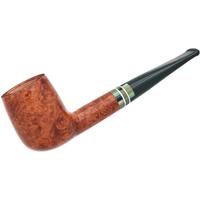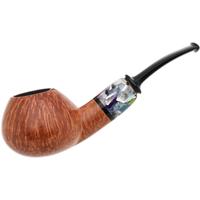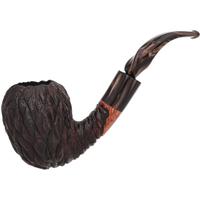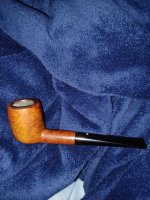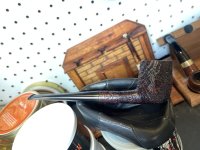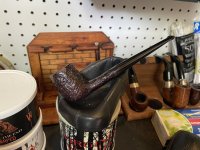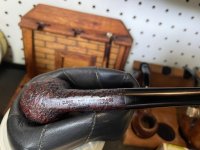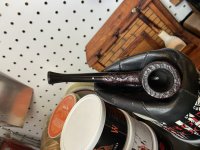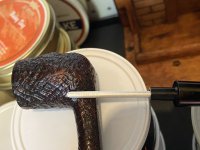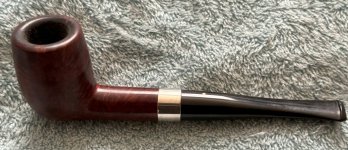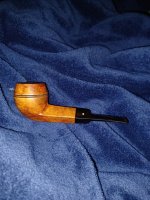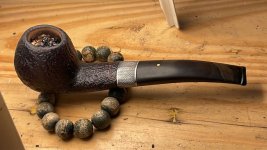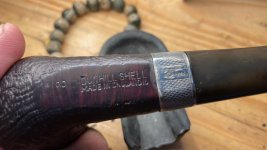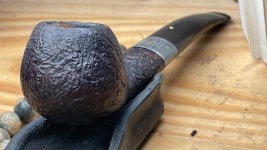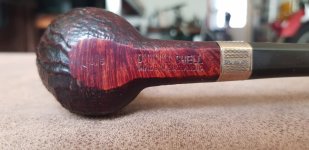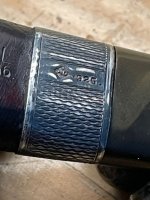Showoff Your Dunhill Pipes Here!
- Thread starter smokeybear
- Start date
You are using an out of date browser. It may not display this or other websites correctly.
You should upgrade or use an alternative browser.
You should upgrade or use an alternative browser.
Well the group 4 smokes absolutely fantastic just like the group 3. The group 2 chestnut not so much. Maybe because it has thin walls and gets hot fast. I tried to slow down with little success. All my dunhills are estates.
The current Dunhill assortment in my pipe drawer
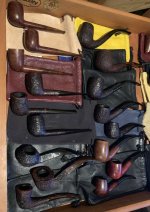
Top to bottom left, then top to bottom right:
'31 Root, shape 36
'39 Root, shape T 35
'38 Root, shape T 142
'57 Shell, shape 59
'35-'54 Shell, shape 60
'64 Shell, shape 104
'59 Shell, shape P
'96 Shilling, no shape #
'99 Cumberland, no shape #
'26 Shell, shape 128
'94 Cumberland, shape 5102
'62 Shell, shape 6 120
'24 Shell, shape 151/9
'23 Shell, shape 12*
'68 Root, shape 56
'72 Bruyere, shape 53
'99 Bruyere, shape 2102
*some people believe the lower-than-30 numbers that occasionally show up on pipes from the '20s are, indeed, anachronistic shape #s. Others have surmised that they are inner tube sizes. I have no basis for an opinion.

Top to bottom left, then top to bottom right:
'31 Root, shape 36
'39 Root, shape T 35
'38 Root, shape T 142
'57 Shell, shape 59
'35-'54 Shell, shape 60
'64 Shell, shape 104
'59 Shell, shape P
'96 Shilling, no shape #
'99 Cumberland, no shape #
'26 Shell, shape 128
'94 Cumberland, shape 5102
'62 Shell, shape 6 120
'24 Shell, shape 151/9
'23 Shell, shape 12*
'68 Root, shape 56
'72 Bruyere, shape 53
'99 Bruyere, shape 2102
*some people believe the lower-than-30 numbers that occasionally show up on pipes from the '20s are, indeed, anachronistic shape #s. Others have surmised that they are inner tube sizes. I have no basis for an opinion.
Amazing collection!The current Dunhill assortment in my pipe drawer
View attachment 296183
Top to bottom left, then top to bottom right:
'31 Root, shape 36
'39 Root, shape T 35
'38 Root, shape T 142
'57 Shell, shape 59
'35-'54 Shell, shape 60
'64 Shell, shape 104
'59 Shell, shape P
'96 Shilling, no shape #
'99 Cumberland, no shape #
'26 Shell, shape 128
'94 Cumberland, shape 5102
'62 Shell, shape 6 120
'24 Shell, shape 151/9
'23 Shell, shape 12*
'68 Root, shape 56
'72 Bruyere, shape 53
'99 Bruyere, shape 2102
*some people believe the lower-than-30 numbers that occasionally show up on pipes from the '20s are, indeed, anachronistic shape #s. Others have surmised that they are inner tube sizes. I have no basis for an opinion.
My favorite shape, in my favorite finish, in my favorite color. WowView attachment 298165View attachment 298166View attachment 298167View attachment 298168View attachment 298169
Cleaned and ready to smoke. ‘49 classic billiard.
I
It definitely it one of the most classic billiard shapesMy favorite shape, in my favorite finish, in my favorite color. Wow
Pipepedia says you are right!Just got this today..pretty beaten up but all originals i think
From the stamping its a Shell, 410 D , 1976 (16 after England) . I cannot find yet anything on the 410 D, most likely transition era before 4 and 5 digit stamps?
View attachment 317204
View attachment 317205
View attachment 317206

I came across a beautiful squat bulldog shape in an old Dunhill catalog and liked it so much I had a copy made by J.T.&D. Cooke
Cooke, James T. - Pipedia - https://pipedia.org/wiki/Cooke,_James_T.
back in the 1990's. Their smooth grain copy was well made and is a great smoker, but it is a bit on the small side.
Fast forward through the decades...I visit, for the first time, the awesome on-line pipe shop https://www.smokingpipes.com/pipes/new/dunhill/moreinfo.cfm?product_id=568048
and find a 2022 rendering of this old and rare shape in the modern Amber Root finish.
The symmetric cross-grain and finish combination is stunning. Photos do not capture its beauty.
The underside particularly is hypnotic in its shimmering chatoyance, like a cat's eye jewel.
You get a better sense of it by watching the pipe's video on the link.
Very happy with the purchase. It is difficult to find well grained Dunhills of recent manufacture, and this shape holds a special place in me heart.
The description from smokingpipes.com:
"The Bulldog is a classic shape, of that there is no doubt, with a distinctly muscular design that focuses the attention on the bowl. Dunhill has here rendered that shape in an interesting way with this "17", featuring muscular shaping cues and a powerful squatness. The stem is a diamond-shaped taper of jet-black vulcanite whose base is lined with a quartet of firm ridgelines, informing the shape of the shank, a stout stretch of briar that transitions smoothly into the bowl. The bowl itself is incredibly squat, resting on a ridged heel and featuring a pair of beadlines that denote a taper toward the rim. This particular offering is dressed in the warm, vibrant stain of the Amber Root series, showcasing handsome grain throughout the stummel.
One of Dunhill's more recent finishes, the Amber Root was introduced in 1995. Like the Root Briar, it showcases a smooth stain, accentuating the briar's natural grain in traditional style. Typically auburn-hued, the Amber Root is often a touch darker in color than that of the Root Briar, pairing handsomely with the jet-black stem for an aesthetic that combines the grain definition of the Root Briar finish with the darker, smokier tones of the Bruyere."
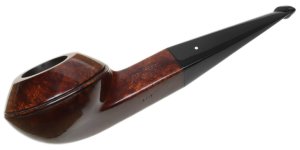

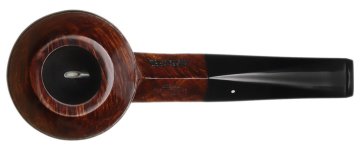

Cooke, James T. - Pipedia - https://pipedia.org/wiki/Cooke,_James_T.
back in the 1990's. Their smooth grain copy was well made and is a great smoker, but it is a bit on the small side.
Fast forward through the decades...I visit, for the first time, the awesome on-line pipe shop https://www.smokingpipes.com/pipes/new/dunhill/moreinfo.cfm?product_id=568048
and find a 2022 rendering of this old and rare shape in the modern Amber Root finish.
The symmetric cross-grain and finish combination is stunning. Photos do not capture its beauty.
The underside particularly is hypnotic in its shimmering chatoyance, like a cat's eye jewel.
You get a better sense of it by watching the pipe's video on the link.
Very happy with the purchase. It is difficult to find well grained Dunhills of recent manufacture, and this shape holds a special place in me heart.
The description from smokingpipes.com:
"The Bulldog is a classic shape, of that there is no doubt, with a distinctly muscular design that focuses the attention on the bowl. Dunhill has here rendered that shape in an interesting way with this "17", featuring muscular shaping cues and a powerful squatness. The stem is a diamond-shaped taper of jet-black vulcanite whose base is lined with a quartet of firm ridgelines, informing the shape of the shank, a stout stretch of briar that transitions smoothly into the bowl. The bowl itself is incredibly squat, resting on a ridged heel and featuring a pair of beadlines that denote a taper toward the rim. This particular offering is dressed in the warm, vibrant stain of the Amber Root series, showcasing handsome grain throughout the stummel.
One of Dunhill's more recent finishes, the Amber Root was introduced in 1995. Like the Root Briar, it showcases a smooth stain, accentuating the briar's natural grain in traditional style. Typically auburn-hued, the Amber Root is often a touch darker in color than that of the Root Briar, pairing handsomely with the jet-black stem for an aesthetic that combines the grain definition of the Root Briar finish with the darker, smokier tones of the Bruyere."




Indeed and also the same Silver band. I can't find any other pipe with similar Silver Band patterns - so probably typical of this "transition era".That is interesting!
I own a Dunhill 616 from '76.
View attachment 317729
View attachment 317728 I could not find any info about it either on the internet. Google 616 and they show a Savinelli pipe.
I thought they might have forgotten the 0 as in shape 6106. Mistery solved... Thank you!


 yeah 616 search is all Sav Authors.
yeah 616 search is all Sav Authors.Indeed and also the same Silver band. I can't find any other pipe with similar Silver Band patterns - so probably typical of this "transition era".

yeah 616 search is all Sav Authors.
I like the type of band. It matches well with my Dunhill lighters. The band on my 616 is 375 gold.
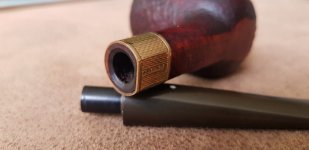
I once had a Canadian with a similar silver band but sold it years ago
I still have another one, a 41091 with similar 375 gold band. But that one does not have a year suffix.
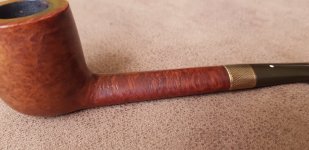
I bought them both from an old man who had quite a collection of Dunhill pipes from the '70s to '80s only.
Last edited:
Spiffy pipes gentsI like the type of band. It matches well with my Dunill lighters. The band on my 616 is 375 gold.
View attachment 317740
I once had a Canadian with a similar silver ring but sold it years ago
I still have another one, a 41091 with similar 375 gold band. But that one does not have a year suffix.
View attachment 317744
I bought them both from an old man who had quite a collection of Dunhill pipes from the '70s to '80s only.
I suppose the bands are factory original to the pipes and not a later addition ?
Omg, love that!I came across a beautiful squat bulldog shape in an old Dunhill catalog and liked it so much I had a copy made by J.T.&D. Cooke
Cooke, James T. - Pipedia - https://pipedia.org/wiki/Cooke,_James_T.
back in the 1990's. Their smooth grain copy was well made and is a great smoker, but it is a bit on the small side.
Fast forward through the decades...I visit, for the first time, the awesome on-line pipe shop https://www.smokingpipes.com/pipes/new/dunhill/moreinfo.cfm?product_id=568048
and find a 2022 rendering of this old and rare shape in the modern Amber Root finish.
The symmetric cross-grain and finish combination is stunning. Photos do not capture its beauty.
The underside particularly is hypnotic in its shimmering chatoyance, like a cat's eye jewel.
You get a better sense of it by watching the pipe's video on the link.
Very happy with the purchase. It is difficult to find well grained Dunhills of recent manufacture, and this shape holds a special place in me heart.
The description from smokingpipes.com:
"The Bulldog is a classic shape, of that there is no doubt, with a distinctly muscular design that focuses the attention on the bowl. Dunhill has here rendered that shape in an interesting way with this "17", featuring muscular shaping cues and a powerful squatness. The stem is a diamond-shaped taper of jet-black vulcanite whose base is lined with a quartet of firm ridgelines, informing the shape of the shank, a stout stretch of briar that transitions smoothly into the bowl. The bowl itself is incredibly squat, resting on a ridged heel and featuring a pair of beadlines that denote a taper toward the rim. This particular offering is dressed in the warm, vibrant stain of the Amber Root series, showcasing handsome grain throughout the stummel.
One of Dunhill's more recent finishes, the Amber Root was introduced in 1995. Like the Root Briar, it showcases a smooth stain, accentuating the briar's natural grain in traditional style. Typically auburn-hued, the Amber Root is often a touch darker in color than that of the Root Briar, pairing handsomely with the jet-black stem for an aesthetic that combines the grain definition of the Root Briar finish with the darker, smokier tones of the Bruyere."
View attachment 317642
View attachment 317644
View attachment 317645
View attachment 317647
Sometimes I rephrase thread titles as I read them -
"Showoff! Your Dunhill pipe's here"





